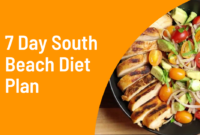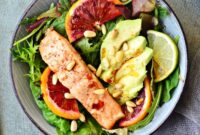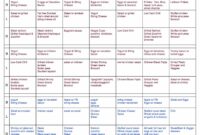South Beach Diet List: Navigating the phases of this popular diet can feel overwhelming, but understanding its core principles—prioritizing healthy fats and lean proteins while limiting refined carbohydrates—is key. This guide provides a detailed breakdown of allowed and restricted foods in each phase, offering meal plans and recipes to help you successfully implement the South Beach Diet. We’ll explore the benefits, potential challenges, and strategies for long-term success, making your journey to a healthier lifestyle smoother and more enjoyable.
From the initial restrictive Phase 1 to the more flexible maintenance phase, we will dissect the South Beach Diet’s approach to weight loss. We’ll compare it to other popular diets, highlighting its unique strengths and considerations. This comprehensive resource aims to equip you with the knowledge and tools necessary to make informed decisions and achieve your health goals.
Understanding the South Beach Diet
The South Beach Diet is a popular weight-loss plan that emphasizes healthy eating habits rather than strict calorie restriction. It focuses on controlling blood sugar levels through careful carbohydrate selection, promoting sustained energy and weight management. Unlike many fad diets, it aims for long-term lifestyle changes, making it a potentially sustainable approach to weight loss.
Core Principles of the South Beach Diet
The South Beach Diet’s core principle revolves around choosing good carbohydrates over bad carbohydrates. “Good” carbohydrates are those that are digested slowly, preventing blood sugar spikes and crashes. These include whole grains, fruits, and vegetables. “Bad” carbohydrates, on the other hand, are those that are quickly digested, leading to rapid blood sugar increases and subsequent crashes, often resulting in increased hunger and cravings. These include refined sugars, white bread, and processed foods. The diet also emphasizes lean protein and healthy fats, crucial for satiety and overall health. This balanced approach aims to promote stable energy levels and curb cravings, facilitating successful weight loss and maintenance.
Phases of the South Beach Diet
The South Beach Diet is structured into three phases, each with progressively less restrictive guidelines.
Phase 1, the initial two-week period, is the most restrictive, eliminating most refined carbohydrates, sugary drinks, and unhealthy fats. This phase focuses on stabilizing blood sugar and initiating weight loss.
Phase 2, which can last for several months, gradually reintroduces healthy carbohydrates, like whole grains and fruits, while continuing to restrict less healthy options. This phase aims to maintain weight loss and further improve health markers.
Phase 3, the maintenance phase, is designed to be a lifelong approach to healthy eating, incorporating a wider variety of foods while maintaining the principles of the diet.
Comparison to Other Popular Diets
Compared to diets like ketogenic or Atkins, which drastically restrict carbohydrates, the South Beach Diet allows for a more moderate intake of healthy carbohydrates, especially in later phases. This makes it potentially easier to adhere to in the long term. Unlike diets that focus solely on calorie counting, the South Beach Diet prioritizes the quality of food over the quantity, emphasizing nutrient-dense choices. It differs from intermittent fasting, as it does not dictate specific eating windows, focusing instead on food selection.
Allowed and Restricted Foods in Each Phase
| Phase | Allowed Foods | Restricted Foods |
|---|---|---|
| Phase 1 | Lean proteins (fish, poultry, beans), healthy fats (avocado, nuts), leafy greens, non-starchy vegetables | Sugary drinks, pastries, white bread, processed foods, high-glycemic fruits (bananas, grapes) |
| Phase 2 | All foods allowed in Phase 1, plus whole grains (brown rice, quinoa), most fruits, some legumes | Most processed foods, sugary drinks, excessive amounts of unhealthy fats |
| Phase 3 | A wider variety of foods, including occasional treats in moderation, maintaining focus on healthy choices | Foods that consistently cause negative health impacts or weight gain |
Food List Breakdown: Phase 1
Phase 1 of the South Beach Diet is a crucial initial step designed to jumpstart weight loss and re-train your body to utilize fats for energy instead of relying heavily on carbohydrates. This initial phase focuses on eliminating high-glycemic carbohydrates and unhealthy fats, prioritizing lean proteins, healthy fats, and non-starchy vegetables. This restrictive approach helps to stabilize blood sugar levels, reduce inflammation, and curb cravings, setting the stage for long-term healthy eating habits.
The following lists detail the foods permitted during Phase 1, categorized for clarity and ease of meal planning. Remember to prioritize whole, unprocessed foods whenever possible.
Allowed Foods in Phase 1: Proteins
Lean protein sources are essential for maintaining muscle mass and satiety during this phase. Adequate protein intake is vital for preventing muscle loss while losing weight. The following protein options are encouraged.
- Chicken breast (skinless)
- Turkey breast (skinless)
- Fish (salmon, tuna, cod, etc.)
- Lean beef (sirloin, tenderloin)
- Eggs
- Beans (in moderation, due to their carbohydrate content)
- Tofu
- Lentils (in moderation, due to their carbohydrate content)
Allowed Foods in Phase 1: Vegetables
Non-starchy vegetables are rich in fiber, vitamins, and minerals, contributing to overall health and aiding in weight management. They are a cornerstone of the South Beach Diet, providing volume and essential nutrients without significantly impacting blood sugar levels.
- Leafy greens (spinach, kale, lettuce)
- Broccoli
- Cauliflower
- Brussels sprouts
- Asparagus
- Green beans
- Bell peppers
- Mushrooms
- Onions
- Tomatoes
- Zucchini
Allowed Foods in Phase 1: Healthy Fats
Healthy fats are crucial for hormone production, nutrient absorption, and satiety. They also contribute to a feeling of fullness, aiding in weight management. These fats are encouraged in moderation.
- Olive oil
- Avocado
- Nuts (almonds, walnuts, pecans – in moderation)
- Seeds (chia, flax, sunflower – in moderation)
- Fatty fish (salmon, mackerel)
Sample Phase 1 Meal Plan
This is a sample meal plan and portion sizes should be adjusted based on individual caloric needs and activity levels. Remember to drink plenty of water throughout the day.
Breakfast: Scrambled eggs (2) with spinach and a small avocado.
Lunch: Grilled chicken salad with mixed greens, bell peppers, and a light olive oil and lemon juice dressing.
Dinner: Baked salmon with roasted broccoli and a small side salad.
Snacks: A handful of almonds or a small avocado.
Food List Breakdown: Phase 2
Phase 2 of the South Beach Diet marks a significant transition, gradually reintroducing foods that were restricted in Phase 1. This phase focuses on expanding your dietary choices while maintaining the core principles of the diet: prioritizing healthy fats, lean proteins, and non-starchy vegetables. The goal is to continue weight loss while building a sustainable, long-term eating plan. This expansion allows for greater variety and helps prevent dietary boredom.
Allowed Foods in Phase 2
The addition of certain foods in Phase 2 significantly broadens the range of meal options. This phase introduces some healthy carbohydrates, but still emphasizes low-glycemic choices to avoid blood sugar spikes. Careful portion control remains crucial.
Foods allowed in Phase 2 include all those permitted in Phase 1, plus:
- Fruits (in moderation): Berries (strawberries, blueberries, raspberries), most citrus fruits (oranges, grapefruits, lemons), and small portions of melon. Avoid high-sugar fruits like bananas and grapes, at least initially.
- Whole Grains (in moderation): Oatmeal (not instant), whole-wheat bread (in limited quantities), brown rice, and quinoa. Focus on smaller portions and pair them with protein and healthy fats.
- Legumes (in moderation): Lentils, chickpeas, and black beans. These are excellent sources of fiber and protein, but should be consumed in controlled portions.
- Nuts and Seeds (in moderation): Almonds, walnuts, pecans, chia seeds, flax seeds. These provide healthy fats and fiber, but are calorie-dense, so portion control is vital.
Gradual Introduction of Foods in Phase 2
The key to success in Phase 2 is the gradual introduction of the newly allowed foods. This allows your body to adjust and helps prevent any negative reactions or weight gain. Start by adding one new food group at a time, monitoring your body’s response, and paying attention to how you feel. If you experience any digestive upset or weight gain, reduce your intake of the new food or temporarily remove it from your diet.
Comparison of Allowed Foods in Phase 1 and Phase 2
The table below summarizes the key differences in allowed foods between the two phases.
| Food Category | Phase 1 | Phase 2 |
|---|---|---|
| Fruits | Limited to low-glycemic options like berries (in small quantities) | Expanded to include most berries, citrus fruits, and small portions of melon. High-sugar fruits still limited. |
| Grains | None | Whole grains like oatmeal (not instant), whole-wheat bread (in moderation), brown rice, and quinoa (in moderation) |
| Legumes | None | Lentils, chickpeas, and black beans (in moderation) |
| Nuts and Seeds | None | Almonds, walnuts, pecans, chia seeds, flax seeds (in moderation) |
Incorporating Fruits into a Phase 2 Meal Plan
A sample Phase 2 meal plan incorporating a variety of fruits might look like this:
Breakfast: Oatmeal with a handful of blueberries and a sprinkle of chopped walnuts.
Lunch: Salad with grilled chicken or fish, mixed greens, a variety of vegetables, and a small portion of orange slices.
Dinner: Baked salmon with a side of brown rice and steamed broccoli, topped with a small amount of sliced strawberries.
This demonstrates how to integrate fruits in moderate portions throughout the day, ensuring a balanced and varied diet while adhering to the principles of Phase 2.
Food List Breakdown: Phase 3 (Maintenance)
Phase 3 of the South Beach Diet marks the transition from structured weight loss to long-term healthy eating habits. This phase isn’t about strict rules but about incorporating the principles you’ve learned into your everyday life to maintain a healthy weight and lifestyle. It’s about sustainable choices, not temporary restrictions.
Principles of the Maintenance Phase
The maintenance phase emphasizes balanced meals, portion control, and mindful eating. It encourages the continued consumption of lean proteins, whole grains, fruits, vegetables, and healthy fats, while minimizing processed foods, sugary drinks, and unhealthy fats. The focus shifts from rapid weight loss to sustainable weight management, ensuring that the weight lost during the previous phases is not regained. This phase allows for more flexibility in food choices compared to the initial phases, but mindful decision-making remains crucial. The goal is to create a personalized eating plan that fits your lifestyle and preferences, allowing for occasional indulgences without derailing your progress.
Healthy Recipes for the Maintenance Phase
Numerous recipes are suitable for the maintenance phase, focusing on whole, unprocessed foods. For example, a grilled salmon with roasted vegetables (broccoli, asparagus, bell peppers) provides a healthy dose of lean protein and fiber. A quinoa salad with chickpeas, cucumber, tomatoes, and a lemon-herb vinaigrette offers a balanced and satisfying meal. Chicken stir-fry with brown rice and plenty of colorful vegetables is another excellent option. These recipes emphasize lean protein sources, complex carbohydrates, and a variety of nutrient-rich vegetables. Remember to adjust portion sizes to meet your individual caloric needs.
Maintaining a Healthy Weight After Completing the Initial Phases
Maintaining a healthy weight after completing the initial phases of the South Beach Diet requires a holistic approach. Regular physical activity is essential, aiming for at least 150 minutes of moderate-intensity exercise per week. This could include brisk walking, cycling, swimming, or any activity you enjoy. Continued focus on mindful eating, paying attention to hunger and fullness cues, helps prevent overeating. Regular weighing and tracking of food intake can provide valuable insights into your eating habits and help you identify areas for improvement. Finally, seeking support from friends, family, or a registered dietitian can provide encouragement and accountability.
Tips for Preventing Weight Regain
It’s crucial to establish sustainable habits to prevent weight regain.
- Prioritize regular exercise: Incorporate at least 30 minutes of moderate-intensity activity most days of the week.
- Maintain a balanced diet: Continue focusing on lean proteins, whole grains, fruits, and vegetables.
- Practice mindful eating: Pay attention to hunger and fullness cues, avoiding distractions while eating.
- Limit processed foods, sugary drinks, and unhealthy fats: These contribute to weight gain and poor health.
- Seek support: Connect with others who share your health goals for motivation and accountability.
- Monitor your weight regularly: Regular weighing helps identify any potential weight gain early on.
- Plan ahead: Prepare meals and snacks in advance to avoid impulsive unhealthy choices.
- Don’t deprive yourself: Allow for occasional treats in moderation to maintain adherence.
Recipe Ideas for the South Beach Diet
The South Beach Diet, known for its phased approach to weight loss, requires careful meal planning. Successfully navigating the diet relies heavily on understanding which foods are permitted in each phase and creatively incorporating them into delicious and satisfying meals. The following recipes offer inspiration for Phase 1 and Phase 2, highlighting the flavors and textures you can enjoy while adhering to the dietary guidelines.
Phase 1 Recipe Ideas
Phase 1 of the South Beach Diet focuses on eliminating sugary foods and refined carbohydrates. These recipes emphasize lean protein, healthy fats, and non-starchy vegetables.
Grilled Salmon with Asparagus and Lemon
Ingredients: 1 salmon fillet (6-8 oz), 1 bunch asparagus, 1 lemon, 2 tbsp olive oil, salt, pepper.
Instructions: Preheat grill to medium-high. Toss asparagus with 1 tbsp olive oil, salt, and pepper. Grill asparagus for 5-7 minutes. Season salmon with salt, pepper, and lemon juice. Grill salmon for 4-6 minutes per side. Serve salmon with grilled asparagus and a lemon wedge.
Chicken and Vegetable Stir-fry
Ingredients: 1 lb boneless, skinless chicken breast (diced), 1 bell pepper (sliced), 1 cup broccoli florets, ½ cup mushrooms (sliced), 2 tbsp olive oil, 2 tbsp soy sauce (low sodium), 1 tbsp ginger (minced), garlic powder.
Instructions: Heat olive oil in a wok or large skillet over medium-high heat. Stir-fry chicken until cooked through. Add bell pepper, broccoli, and mushrooms. Stir-fry for 5-7 minutes. Add soy sauce and ginger. Cook for another minute. Serve hot.
Spinach and Feta Omelet
Ingredients: 2 large eggs, 1 cup spinach (chopped), 2 tbsp crumbled feta cheese, 1 tbsp olive oil, salt, pepper.
Instructions: Whisk eggs with salt and pepper. Heat olive oil in a non-stick skillet over medium heat. Pour egg mixture into skillet. Sprinkle spinach and feta cheese over eggs. Cook until eggs are set. Fold omelet in half and serve.
Phase 2 Recipe Ideas
Phase 2 introduces some healthy carbohydrates back into the diet, expanding your options. These recipes incorporate whole grains and legumes while maintaining the focus on lean protein and healthy fats.
Lentil Soup
Ingredients: 1 cup brown or green lentils, 4 cups vegetable broth, 1 carrot (diced), 1 celery stalk (diced), 1 onion (chopped), 2 cloves garlic (minced), 1 tsp cumin, salt, pepper.
Instructions: In a large pot, sauté onion, carrot, and celery in olive oil until softened. Add garlic and cumin, cook for 1 minute. Add lentils and vegetable broth. Bring to a boil, then reduce heat and simmer for 30-40 minutes, or until lentils are tender. Season with salt and pepper.
Turkey Meatloaf with Zucchini Noodles
Ingredients: 1 lb ground turkey, ½ cup chopped onion, ½ cup breadcrumbs (whole wheat), 1 egg, 1 tbsp tomato paste, 1 zucchini (spiralized), salt, pepper.
Instructions: Preheat oven to 375°F. Combine ground turkey, onion, breadcrumbs, egg, and tomato paste in a bowl. Season with salt and pepper. Form into a loaf and bake for 30-40 minutes. Serve with zucchini noodles.
Quinoa Salad with Grilled Chicken
Ingredients: 1 cup quinoa, 1 cup cooked chicken (diced), ½ cup chopped cucumber, ½ cup chopped tomatoes, ¼ cup chopped red onion, 2 tbsp olive oil, 2 tbsp lemon juice, salt, pepper.
Instructions: Cook quinoa according to package directions. Combine cooked quinoa, chicken, cucumber, tomatoes, and red onion in a bowl. Whisk together olive oil, lemon juice, salt, and pepper. Pour dressing over salad and toss to combine.
Sensory Descriptions of South Beach Diet Meals
The vibrant colors, diverse textures, and enticing aromas are key elements of a successful and enjoyable South Beach Diet.
Meal 1: Grilled Salmon with Asparagus – Imagine the bright orange of the perfectly grilled salmon contrasting with the vibrant green of the tender asparagus spears. The aroma is a delightful blend of smoky grill marks and the subtle sweetness of the lemon. The texture is a satisfying combination of flaky fish and crisp-tender vegetables.
Meal 2: Lentil Soup – A hearty bowl of lentil soup offers a warm, earthy aroma with hints of onion and garlic. The colors are a rich tapestry of orange carrots, green lentils, and the deep brown of the broth. The texture is a delightful mix of tender lentils, slightly crunchy vegetables, and a smooth, flavorful broth.
Meal 3: Quinoa Salad with Grilled Chicken – This salad is a feast for the eyes, with the vibrant colors of the quinoa, juicy chicken, and fresh vegetables. The aroma is light and refreshing, with a hint of lemon and herbs. The texture is a pleasant mix of fluffy quinoa, tender chicken, and crisp vegetables, all coated in a light and zesty dressing.
Epilogue
Embarking on the South Beach Diet is a journey towards a healthier lifestyle, and this guide serves as your trusted companion. By understanding the dietary principles, meticulously following the phase-specific food lists, and employing the provided strategies for overcoming challenges, you’ll be well-equipped to navigate the process successfully. Remember, consistency and mindful choices are crucial for achieving long-term weight management and overall well-being. The South Beach Diet, with its balanced approach and emphasis on healthy eating habits, can be a powerful tool for transforming your relationship with food and achieving sustainable results.




